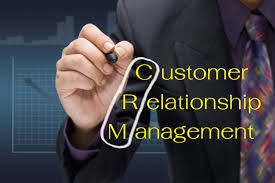Unlock the value of CRM
 In today’s complex business world a customer’s perception is reality. No business can afford to take the customer for granted. And, customers sometimes get things wrong. Customers are an asset though they are not listed as an asset in balance sheets and financial reports. Customer Relationship Management CRM requires to be placed in the centre of an organization’s business process because customers recognize when an enterprise does not value them or care about their needs.
In today’s complex business world a customer’s perception is reality. No business can afford to take the customer for granted. And, customers sometimes get things wrong. Customers are an asset though they are not listed as an asset in balance sheets and financial reports. Customer Relationship Management CRM requires to be placed in the centre of an organization’s business process because customers recognize when an enterprise does not value them or care about their needs.
Companies that possess knowledge about their customers can use it to their profitable advantage and are wildly successful. Knowing in particular what buyers want always helps organizations to build and deliver the precise solutions to meet customers’ needs. They offer their products at the right time, right locations, at the right price, and with the suitable warranties. Companies which are CRM savvy deliver their products and services with the right features and support their customers to create positive buying experiences.
Conversely, organizations which don’t focus on their customers often fail. A bonding with the individuals who might buy their products is essential, but for some reason, many miss this absolutely critical aspect of business. All too often, organizations spend their energy on everything but lack to have conversations with current and potential customers.
 The American Consumer Satisfaction Index (ASCI) reports indicate that within the Personal Computers (PC) category, customers perceived Apple as the best company in terms of customer service management. Apple’s baseline scores are excellent. Apple focuses on product innovation and customer service round the clock. Similarly, in the major appliances category, as per the ACSI survey General Electric company (GE) stands at no. 1. Among many other things, GE’s blog is a very good way for the organizations to keep in touch with their customers, and GE is one of the few corporate that has its own blogs especially to sort out customer’s problems.
The American Consumer Satisfaction Index (ASCI) reports indicate that within the Personal Computers (PC) category, customers perceived Apple as the best company in terms of customer service management. Apple’s baseline scores are excellent. Apple focuses on product innovation and customer service round the clock. Similarly, in the major appliances category, as per the ACSI survey General Electric company (GE) stands at no. 1. Among many other things, GE’s blog is a very good way for the organizations to keep in touch with their customers, and GE is one of the few corporate that has its own blogs especially to sort out customer’s problems.
Smart organizations believe that it’s easier to keep existing customers happy than attract new ones. Imagine the amount of revenue is spent on trying to attract new customers to a business when all you really needed to do is to keep the existing customers happy. The promotional budgets are always higher than the CRM budgets. When you give your existing customers a great customer experience they can work optimistically for you though word of mouth and referrals.
 Social media: Complaints spread like wildfire on the Internet. The social media works like wild fire because of its far flung reach. Because of social media we have been more connected than we were in past. Today on social sites people share their good and bad experiences and the post can go viral through social media, highlighting poor experience of a customer about a company to millions of people. Simultaneously, it can work wonders too if smartly used. For example, Lay’s created a feeding frenzy across the social media landscape with “Do Us a Flavor,” challenging consumers to create new Lay’s potato-chip flavors for the chance to win $1 million or 1 percent of the winning chip flavor’s net sales. The campaign was rolled out to U.S. junk-food junkies in mid-2012, the campaign generated close to 4 million flavor ideas through a Facebook app and SMS. A panel of chefs, celebrity foodies and flavor experts selected three finalists: Cheesy Garlic Bread, Chicken & Waffles and Sriracha. Parent company Frito-Lay developed and released all three and named Cheesy Garlic Bread the winner in May 2013, after more than 1 million consumers voted via Facebook, Twitter or text.
Social media: Complaints spread like wildfire on the Internet. The social media works like wild fire because of its far flung reach. Because of social media we have been more connected than we were in past. Today on social sites people share their good and bad experiences and the post can go viral through social media, highlighting poor experience of a customer about a company to millions of people. Simultaneously, it can work wonders too if smartly used. For example, Lay’s created a feeding frenzy across the social media landscape with “Do Us a Flavor,” challenging consumers to create new Lay’s potato-chip flavors for the chance to win $1 million or 1 percent of the winning chip flavor’s net sales. The campaign was rolled out to U.S. junk-food junkies in mid-2012, the campaign generated close to 4 million flavor ideas through a Facebook app and SMS. A panel of chefs, celebrity foodies and flavor experts selected three finalists: Cheesy Garlic Bread, Chicken & Waffles and Sriracha. Parent company Frito-Lay developed and released all three and named Cheesy Garlic Bread the winner in May 2013, after more than 1 million consumers voted via Facebook, Twitter or text.
For an organization to become victorious with their CRM initiatives, it is important to focus on the two key strategies technology and CRM strategy. These two strategies are the sum-total of planning, development and implementation activities needed to achieve a company’s customer-related goals. CRM technology is the systems-based application and integration that facilitates and supports the customer interaction. In order to ensure the highest likelihood for CRM success, the organization needs to invest in technology and a deep insight is also required as to what is realistic. A proper strategy must be put in place in order to correctly implement and deploy technology.
Segmenting your customers rightly, targeting your product and service at them rightly and positioning your product on the right plank are essential. You should understand the different types of customers you deal with. Look at your team and identify members those who are not always putting the customer first. They are dangerous for the team.
 Data-Driven Decision Making: At its core, CRM is all about making smart decisions based on good data-capturing. The most important step, but it can also be the most difficult because it involves various changes such cultural change, trends change, technological change, economic change, policies change so on and forth. The problems with each of these are that they are not easily shared, they are often temporary, and they cannot be analyzed if not captured methodically. One of the biggest problems facing decision makers is their inability to use data captured by the employees working directly with customers to make decisions. This is the case because many ERP systems make it difficult for end users to enter data such as call notes into a database. And when simple tasks become difficult, employees stop doing them. Even if you aren’t working on a system that makes it easy to enter and share collected data, it is important to get all employees in the habit of entering useful information into the system so it can be used optimally while making strategies and analyzed. The record helps organization when employees leave and walk out of the organization and the data is not lost with their exit.
Data-Driven Decision Making: At its core, CRM is all about making smart decisions based on good data-capturing. The most important step, but it can also be the most difficult because it involves various changes such cultural change, trends change, technological change, economic change, policies change so on and forth. The problems with each of these are that they are not easily shared, they are often temporary, and they cannot be analyzed if not captured methodically. One of the biggest problems facing decision makers is their inability to use data captured by the employees working directly with customers to make decisions. This is the case because many ERP systems make it difficult for end users to enter data such as call notes into a database. And when simple tasks become difficult, employees stop doing them. Even if you aren’t working on a system that makes it easy to enter and share collected data, it is important to get all employees in the habit of entering useful information into the system so it can be used optimally while making strategies and analyzed. The record helps organization when employees leave and walk out of the organization and the data is not lost with their exit.
 Enhance your data: There are two primary ways to enhance your data. You can do this internally through marketing efforts to gather more information about your customer base and you can purchase third-party data to enhance what you already have. Analyze your data. Only when you have a culture that is committed to capturing data can you trust the data enough to analyze it and make strategic decisions based on your analysis. You can create reports that measure the performance of your marketing campaigns, the response to your advertising campaigns, existing customer’s reactions, new customers who are thinking positively about your product, costing gaps, pricing gaps, distribution gaps, supply chain management gaps, R&D needs etc, etc. It is the best way to inform your institution on changes that need to be made, and it will provide the data you need to make those decisions.
Enhance your data: There are two primary ways to enhance your data. You can do this internally through marketing efforts to gather more information about your customer base and you can purchase third-party data to enhance what you already have. Analyze your data. Only when you have a culture that is committed to capturing data can you trust the data enough to analyze it and make strategic decisions based on your analysis. You can create reports that measure the performance of your marketing campaigns, the response to your advertising campaigns, existing customer’s reactions, new customers who are thinking positively about your product, costing gaps, pricing gaps, distribution gaps, supply chain management gaps, R&D needs etc, etc. It is the best way to inform your institution on changes that need to be made, and it will provide the data you need to make those decisions.
One final thought about CRM: It is not a destination, it is a journey. If your organization makes the decision to undertake a CRM implementation, the process is not over when the system is installed. In fact, it is just a beginning. Once you start, you cannot stop. Therefore, the decision to begin should not be taken vaguely or lightly. However, at once your firm commits to a CRM viewpoint; it will forever change how you do business and how you view your customers. The phrase “the customer is king” is now more true than ever. The abundance of buyer information currently available through the explosion of cloud, social and mobile platforms has enabled buyers to learn about a product before the buying process. Only CRM will help to effectively measure and react with customer engagement.













































